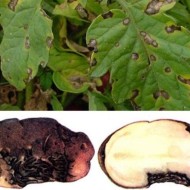20 potato diseases and effective control measures
Content
Causes of potato disease
The main causes of damage to potatoes are:
- poor quality planting material;
- non-compliance with agrotechnical rules;
- violation of crop rotation;
- insufficient care.
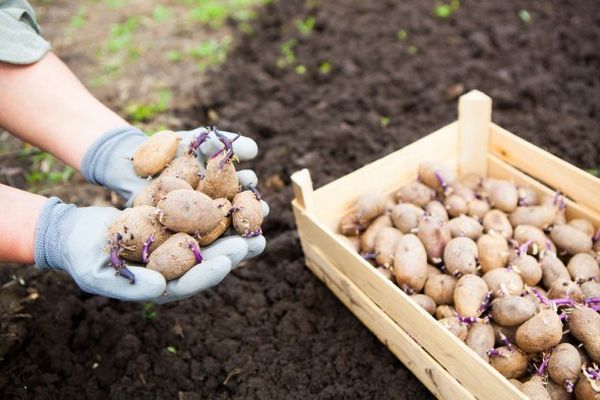
Also, the plant may suffer from inappropriate climatic conditions. To eliminate this factor, experienced farmers recommend planting varieties that are suitable for a specific region.
Video "How to process potatoes"
In this video, an expert will tell you how to properly process potatoes.
Symptoms of defeat
It is rather difficult to define a disease without the necessary knowledge. This often happens too late when it is time to harvest. However, there are several signs that will help you detect the problem in time:
- the presence of aphids;
- yellowing of the leaves;
- withering;
- slow growth.
At the first signs of pathology, you need to immediately take the necessary measures. They consist in the selection of a fungicide and timely processing.
Bacterial diseases of potatoes
Affected tubers or soil are carriers of pathogenic bacteria. Pathogenic microorganisms that cause diseases are resistant to temperature extremes and adverse conditions. The problem is that there is no cure for bacterial diseases. The only way to reduce the risk of infection is through prevention.
Brown bacterial rot
Potato tubers are the object of pathogens. Healthy on the inside, they are covered with a girdle layer of reddish-brown rot. If the affected area is large, moist areas of a dark shade appear on the skin. The aerial part of the plant withers quickly, the leaf plates are deformed and turn yellow. In order to prevent the development of brown rot, gardeners recommend processing the planting material before planting and not disrupting the crop rotation.
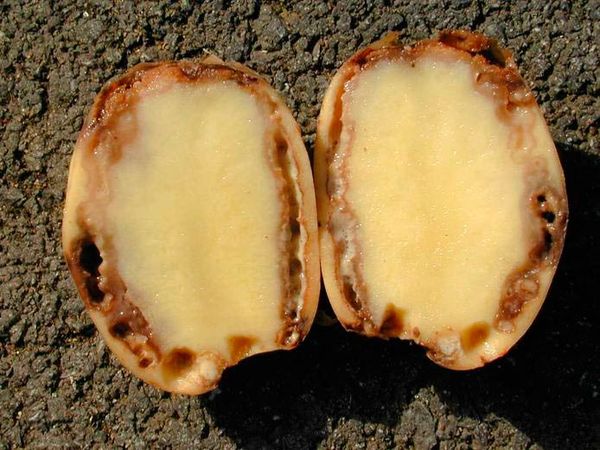
Ring rot
The disease is difficult to diagnose due to poorly expressed symptoms. It is possible to determine the presence of ring rot only on the cut. When a piece of tops is squeezed, a putrefactive substance of a yellowish or brown hue is released from it. On infected tubers, areas with a sticky yellow-brown content appear. Fertilization of the soil with nitrogenous and potassium compounds, as well as good drying of the crop, will help prevent disease.

Wet rot
Pathogenic bacteria that cause wet rot attack the tubers and the aerial part.The leaf plates change shape, curl, and extensive dark brown areas appear on them. The fruits of the potatoes look healthy outwardly, but when cross-sectioned, it can be seen that they are actively rotting from the inside. It is impossible to get rid of the disease. For prophylaxis, planting material is stored in a dry place, avoiding moisture and temperature rise.

Mixed internal rot
The disease is unusual in that it most often manifests itself on an already harvested crop. The cause of its occurrence is often mechanical damage to the tubers. Through open areas, pathogenic bacteria enter the vegetable, which cause rapid rotting of the potato. Experienced farmers recommend observing preventive measures, which include processing the storage area with a solution of copper sulfate, as well as regular cleaning.
Blackleg
Bacteria love cabbage, and therefore planting potatoes after this culture is not worth it. The first sign of the disease is stem decay at the root. The leaf plates roll up like a tube and lose their density. Tubers affected by the black leg become soft, covered with moist putrefactive spots, from which a characteristic odor emanates. To prevent disease, before planting, the planting material is treated with a special agent, and the site is thoroughly cleaned of diseased plants.

Fungal diseases
Disease fungi infect the whole potato crop, threatening to destroy most of the crop. Spores multiply quickly and in a short time can settle throughout the entire area. In addition, they reduce the plant's immunity, making it less resistant to other infections. You can fight the disease with the help of fungicides, and for prevention purposes, you can prevent waterlogging of the soil.
Alternaria
The disease is more commonly known as dry spotting. Late varieties of potatoes are susceptible to it. The first sign of damage is dark areas on the leaf blades, which very quickly cover the tops, causing them to fall off. The tubers are covered with depressed spots of a dark brown, almost black color, and the skin is collected in small folds. The disease can be avoided by treating the planting material or already an adult culture with fungicides.
Verticillosis
Wilt's symptoms are quite extensive. The onset of the disease is characterized by damage to the upper part of the plant. Potato growth slows down, and leaf plates are covered with yellowish spots. As the infection spreads, they turn reddish-brown. The tops begin to wither and soon fall off. Sometimes a bluish or pink bloom can be seen on the lower part of the sheet. Infected tubers quickly deteriorate and become unusable.
Verticillosis is not treatable, since the fungi that cause the disease are resistant to any fungicide.
Powdery mildew
Powdery mildew symptoms appear at the end of flowering. The infection affects the aerial part of the plant and is characterized by reddish-brown spots covering the lower part of the leaf plate. Over time, they increase in size, covering large areas, and a gray-white mold appears on the surface. The tops wilt, from which they completely fall off the stem. To combat the disease, fungicidal preparations are used, and the soil is treated with potassium-phosphorus compositions.
- Scab infects tubers
- Powdery mildew
- Alternaria potato
Scab
The disease affects tubers and has several forms:
- Ordinary. It is expressed in the ulcerated surface of potato fruits, as well as cracking of the skin.
- Powdery. Vegetables become covered with spots of various shapes, which eventually form ulcers, where fungi multiply.
- Silver. The main symptoms are wrinkled skin with gray areas, which soon darken, spreading to the tuber itself.
In addition to observing crop rotation, gardeners recommend treating with fungicides and ammonium sulfate.
Button rot, or phomosis
The signs of the fungus appear even during the formation of the fruit. The lower part of the stem is covered with dark brown spots and begins to rot. The disease continues to develop even after harvest. On the tubers, black depressed areas appear, similar to ulcers, in which pathogenic spores collect. Under their influence, the potatoes dry out quickly, becoming unusable. Methods for combating phomosis are the same as for other fungal diseases.
Potato cancer
A very dangerous disease that can harm human health if affected vegetables are consumed. It is expressed in large growths that are located near the eyes, and eventually cover the entire tuber. Sometimes the disease can be diagnosed by the appearance of the plant, when the neoplasms spread to the aerial part. No cancer control methods have been found yet. It is recommended to observe crop rotation and plant varieties resistant to this infection.

Rhizoctonia
The disease is better known as black scab. Vegetables develop black, mud-like patches. The aboveground part of the potato becomes prone to wilting. The leaf plates lose their shape, and the stem becomes whitish. To avoid rhizoctonia, it is necessary to follow the rules of crop rotation, as well as give preference to varieties with increased immunity. Before planting, the tangles are treated with a fungicide.
Late blight
The most common disease among nightshades. It can be identified by the dark brown spots covering the top of the leaf plate. On the reverse side, a white-gray mold forms on the tops. Over time, the aerial part wilts or decays, and the tubers become ulcerated, dense areas of dark brown color. You can get rid of late blight with the help of a Bordeaux mixture.
Fusarium
The first symptoms of fusarium appear on the tops. The top gets lighter and the bottom gets a purple hue. Soon, the leaf plates fade rapidly. The stalk of the potato turns brown, covered with a creamy mildew and begins to rot. Fuzzy white-gray patches appear on the fruits, and the texture of the vegetable becomes loose. To protect neighboring bushes, the affected specimens are dug up. Before planting, the tubers are treated with a fungicide.
Potato viral diseases
The overground part of the culture becomes the zone of infection with viral diseases. As a result of infection, the plant slows down growth, becomes weakened, and its productivity drops significantly. In addition to mosaic, potatoes can suffer from other diseases, which we will discuss below.
Common viral mosaic
Common viral mosaic is often confused with common iron deficiency. To accurately establish a diagnosis, the plant must be observed. The first signs of the disease appear in the form of a yellowish spot on the leaf plates. If the culture is infected with a virus, over time it becomes dark brown with a red tint. Sick specimens must be removed from the site and burned. For prevention, treatment with antiviral agents can be carried out.
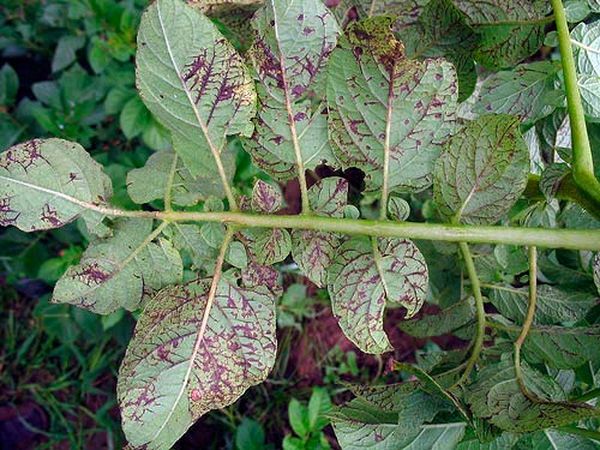
Wrinkled mosaic
The risk of contracting the virus increases during periods of drought. The plant's growth slows down significantly, which negatively affects its productivity. The tops also suffer - the leaf plates become wrinkled, brighten to a light green hue, but do not fall off. Remaining dead on the stem, they destroy the entire plant as a whole. Experienced farmers recommend sprinkling potatoes in a timely manner and following all agrotechnical rules.
Striped mosaic
The disease is caused by different strains of viruses, and therefore the symptoms may differ slightly.However, there are basic signs by which a striped mosaic can be diagnosed. Potato shoots lose their flexibility and become brittle. The aboveground part of the plant is covered with spots of various sizes. The veins of the leaf plates are colored dark brown or dark purple. The virus multiplies very quickly, and therefore the diseased bush must be destroyed. Disease can be prevented with preventive treatment.
Gothic tubers
When damaged by the Gothic, the upper part of the plant significantly changes its appearance. The leaf plates become small, lanceolate. Large areas of purple-red color appear on the surface. Over time, tubers suffer. They stop their growth, stretch out, acquire a fusiform shape. To fight the infection, it is necessary to process the seed, and also to remove pests in time.
Tuber necrosis
To determine necrosis, it is enough to observe the plant. The green part is covered with a small yellowish spot, and the flowers are deformed. After a lapse of time, the virus passes to the fruits of the potato - necrotic areas are formed on them. The structure of the tuber changes dramatically, and the level of starchiness becomes lower. Gardeners are advised to observe crop rotation, as well as to carry out preventive spraying in order to avoid illness.
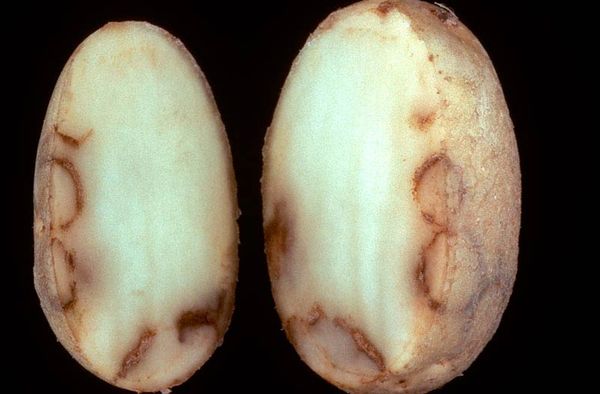
Leaf curl, or PLRV virus
The most common cause of the disease is aphids. It is these insects that carry the dangerous virus. However, pathogenic microorganisms can also be found in the planting material. The leaf plates curl around the edges and lose their color. The tubers become covered with necrotic spots and the starch level becomes very low.
Prevention of potato diseases
Preventive measures will help to save the harvest and not ruin the plants:
- do not disturb crop rotation;
- timely process the planting material with special means;
- choose hybrids with increased immunity to diseases;
- weed the soil regularly, removing weeds;
- thoroughly clean the site of potato residues immediately after harvest;
- take care of plants.
Solanaceous crops are often susceptible to various infections. You can reduce the risk of their occurrence by periodically inspecting the bushes. And if the first signs of a problem are identified, appropriate measures should be taken in time.



